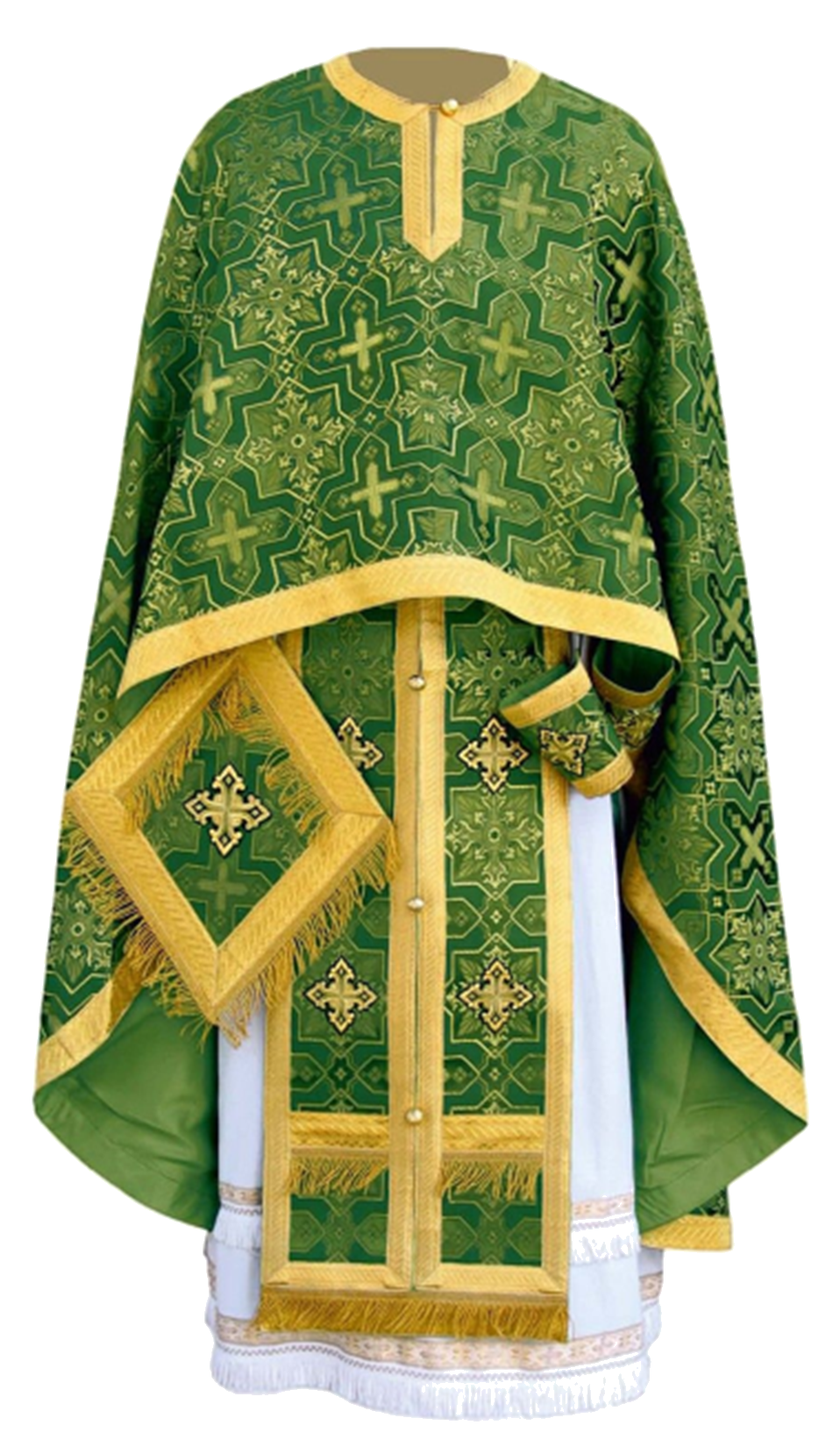Phelonion-Epigonation

In addition to the stikharion, the epitrachelion, the cuffs and the zone, the Priest wears a long sleeveless garment, called a PHELONION (GR feloni[on]; SL felon). Short in front, with an elongated back, and an opening for the head, it is one of the most ancient vestments of the Church. It represents the red tunic with which the Romans dressed the Savior before his Crucifixion, and denotes that the priests are invested with truth and should be ministers of the truth. In its present form, the front is largely cut away (from about the waist down) to facilitate the priest's movements. A bishop who wishes to serve a Divine Liturgy as a priest (i.e., without the special rites and prayers of the Hierarchical Divine Liturgy) will sometimes vest in a phelonion instead of his sakkos (vestment worn by Orthodox bishops instead of the priest’s phelonion). There are two main styles of phelonion. Byzantine or Greek phelonia are tailored to fit over the shoulders, while Russian phelonia have a high, stiffened collar that covers the back of the head. The EPIGONATION (GR "on the knee"; SL Palitsa or Nabedrennik) is a diamond-shaped vestment suspended from the belt and hung over the right side above the knee of a clergyman of higher rank. It signifies the cloth used by Christ to wipe his disciples' feet before the Last Supper and also signifies the sword of the Spirit that is the strength of the Word of God. In the Byzantine tradition, the epigonation is awarded to a priest upon his elevation to confessor. It is decorated with an embroidered cross, the figure of the Savior or that of an angel. Vestments remind the celebrants that they "are not of the world" (Jn 17:16) but participants of Christ's glory (Jn 17:22-24) clothed in the robes and the grace of the Holy Spirit.
Phélonion-Épigonation
Le PHÉLONION (pluriel, phelonia) est un vêtement liturgique porté par-dessus tous les autres vêtements, c'est-à-dire par-dessus le stikharion, l'épitrachelion, les épimanikia et la zone, et qui complète l'habillement du clergé. À l'époque byzantine, il était de forme ronde, sans manches, avec juste une ouverture pour passer la tête; il couvrait tout le corps et pouvait se relever avec des cordons pour le service liturgique. Cette forme s'est plus ou moins conservée dans les Églises grecques. Il symbolise la tunique que portait le Christ au moment de sa comparution devant Ponce Pilate. Dans sa forme actuelle, l'avant est largement réduit, afin de faciliter les mouvements du prêtre. L'usage du phélonion n'est pas restreint à la Divine Liturgie, mais est réservé à tous les usages liturgiques importants. Il signale au prêtre la gloire qui l’enveloppe. Il existe deux styles de phélonion. Les phélonia grecs ou byzantins sont taillés de sorte à s'adapter aux épaules, tandis que les phélonia russes (connu sous le nom de felon ou phelon) ont un col raide, élevé, qui couvre le dos de la tête. Un évêque qui souhaite servir lors de la Divine Liturgie comme prêtre (c.-à-d. sans les rites ni les prières spécifiques de la Divine Liturgie Hiérarchique) revêtira parfois le phélonion à la place du sakkos (vêtement liturgique réservé aux évêques, patriarches et métropolites). L'ÉPIGONATION est un losange recouvert d'une étoffe de la couleur du phélonion, suspendu à la ceinture par une cordelette du côté droit, à hauteur du genou. Il symbolise «le bouclier de la foi» (Ép. 6:16), la victoire sur la mort par la Résurrection du Christ. Il s'agit d'une marque honorifique ecclésiastique; dans la pratique byzantine, il désigne un prêtre ayant reçu le charisme de la confession. Le port des vêtements liturgiques rend le clergé semblable à des icônes vivantes de Notre-Seigneur et de ses anges servant à l'autel de Dieu.